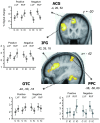Left Amygdala Regulates the Cerebral Reading Network During Fast Emotion Word Processing
- PMID: 32038435
- PMCID: PMC6989437
- DOI: 10.3389/fpsyg.2020.00001
Left Amygdala Regulates the Cerebral Reading Network During Fast Emotion Word Processing
Abstract
Emotion words constitute a special class of verbal stimuli which can quickly activate the limbic system outside the left-hemisphere language network. Such fast response to emotion words may arise independently of the left occipitotemporal area involved in visual word-form analysis and rely on a distinct amygdala-dependent emotion circuit involved in fearful face processing. Using a hemifield priming paradigm with fMRI, we explored how the left and right amygdala systems interact with the reading network during emotion word processing. On each trial, participants viewed a centrally presented target which was preceded by a masked prime flashed either to the left or right visual field. Primes and targets, each denoting negative or positive nouns, could be either affectively congruent or incongruent with each other. We observed that affective congruency produced parallel changes in neural priming between the left frontal and parietotemporal regions and the bilateral amygdala. However, we also found that the left, but not right, amygdala exhibited significant change in functional connectivity with the neural components of reading as a function of affective congruency. Collectively, these results suggest that emotion words activate the bilateral amygdala during early stages of emotion word processing, whereas only the left amygdala exerts a long-distance regulatory influence over the reading network via its strong within-hemisphere connectivity.
Keywords: affective priming; amygdala; emotion words; functional connectivity; reading; repetition suppression and enhancement.
Copyright © 2020 Nakamura, Inomata and Uno.
Figures





References
-
- Amano S., Kondo T. (2000). Nihongo-no goitokusei [lexical properties of Japanese]. Tokyo: Sanseido.
LinkOut - more resources
Full Text Sources

